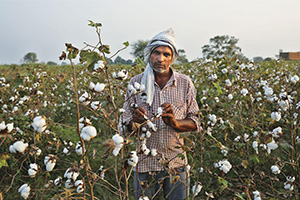
Falling Indian domestic price gap to boost cotton imports
YarnsandFibers News Bureau 2019-07-18 14:00:00 –The continuing contraction in international and domestic cotton prices following higher global production and a decline in domestic output is likely to boost imports further this year, says a report. The gap or spread between global and domestic cotton prices has been on a declining trend owing to higher production in Brazil and China, coupled with a fall in domestic production, says an India Ratings report Tuesday.
The decreasing price spread, along with a gradual improvement in demand, has come as a relief to the cotton industry, adds the report. With the contraction in the price gap, the agency expects increasing imports in FY20.
Cotton accounts for 51 percent of the raw material cost in the textile industry, putting pressure on the margin, it said, adding raw material cost inflation is difficult to pass on due to subdued consumer demand. For the current sowing season began last October, output projection has been lowered by 0.6 million bales owing to scarcity of water in some of the key growing states and the resultant lower acreage and crop yield. This means that 1.5 million bales will need to be imported to meet domestic demand, the report said.
Meanwhile, the report also said yarn production has been fluctuating over the past six months, although the production average has been maintained. As a result yarn exports have gone up to more than 30 percent in March alone. As cotton yarn prices are co-related to raw cotton prices, it has seen an upward movement in line with raw cotton prices, it added.
Meanwhile, synthetic fabric has seen a gradual revival in demand due to a dip in cost of production, aided by a fall in crude prices, making it more competitive against increasing cotton prices, the report says. The report further notes that export of readymade garments has also declined as the world economy has slowed and removal of tax incentives for exports have made domestic textiles less competitive compared to Vietnam and Bangladesh, which have seen their market share improving in the global textile industry.
Falling exports following weak consumer sentiment have also impacted the industry's capacity utilization as a result capex has mostly been to replace machines/adopt new technologies or to shift to niche products in the existing line-up, it notes.
Courtesy: Economic Times
Market Intelligence
Ask for free sample Report

experience
Customer Base
dedicated team
Countries Served Worldwide









